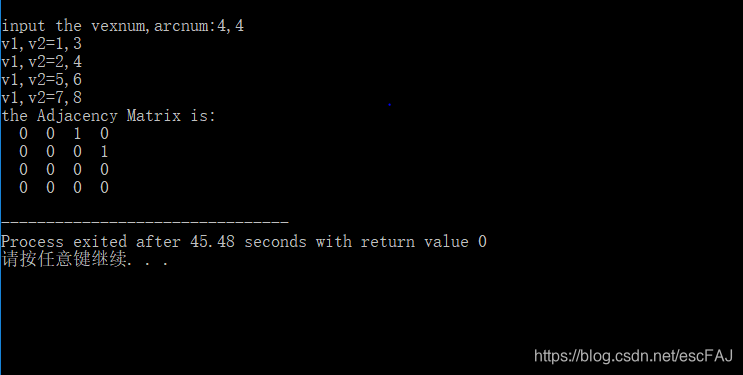数据结构之图的常用存储结构,及其典型应用,递归算法
一、实验目的
- 熟悉图的两种常用的存储结构,即邻接矩阵和邻接表,以及在这两种存储结构上的遍历图的方法,即深度优先遍历和广度优先遍历。
- 进一步掌握递归算法的设计方法。
- 了解图的典型应用的算法程序。
二、实验内容:
- 建立图的邻接矩阵存储结构(数组表示),并将邻接矩阵输出。
- 建立图的邻接表存储结构,并将邻接表输出。
- 图的深度优先遍历。
- 图的广度优先遍历。
三、实验要求
在本题下面提交源程序和实验运行结果截图。
1. 建立图的邻接矩阵存储结构(数组表示),并将邻接矩阵输出。
#include<stdio.h>
#define max 100
int creatcost(int cost[][max])
{ int vexnum,arcnum,i,j,k,v1,v2;
printf("\ninput the vexnum,arcnum:");
scanf("%d,%d",&vexnum,&arcnum);
for(i=1;i<=vexnum;i++)
for(j=1;j<=vexnum;j++)
{
cost[i][j]=0;
}
for(k=0;k<arcnum;k++)
{ printf("v1,v2=");
scanf("%d,%d",&v1,&v2);
cost[v1][v2]=1;
}
return vexnum;
}
int main()
{
int i,j,vexnum;
int cost[max][max];
vexnum=creatcost(cost);
printf("the Adjacency Matrix is:\n");
for(i=1;i<=vexnum;i++)
{
for(j=1;j<=vexnum;j++)
printf("%3d",cost[i][j]);
printf("\n");
}
return 0;
}
四、实验结果。

- 建立图的邻接表存储结构,并将邻接表输出。
#include<stdio.h>
#include<malloc.h>
#define max 100
typedef struct node
{
int adjvex;
struct node*next;
}arcnode;
typedef struct
{
int vertex;
arcnode*firstarc;
}vexnode;
vexnode adjlist[max];
int creatadjlist()
{
arcnode*ptr;
int arcnum,vexnum,k,v1,v2;
printf("input the vexnum,arcnum:");
scanf("%d,%d",&vexnum,&arcnum);
for(k=1;k<=vexnum;k++)
adjlist[k].firstarc=0;
for(k=0;k<arcnum;k++)
{
printf("v1,v2=");
scanf("%d,%d",&v1,&v2);
ptr=(arcnode*)malloc(sizeof(arcnode));
ptr->adjvex=v2;
ptr->next=adjlist[v1].firstarc;
adjlist[v1].firstarc=ptr;
ptr=(arcnode*)malloc(sizeof(arcnode));
ptr->adjvex=v1;
ptr->next=adjlist[v2].firstarc;
adjlist[v2].firstarc=ptr;
}
return vexnum;
}
int main()
{
int i,n;
arcnode*p;
n=creatadjlist();
printf("the Adjacency List:\n");
for(i=1;i<=n;i++)
{
printf("%d=>",i);
p=adjlist[i].firstarc;
while(p!=NULL)
{
printf("---->%d",p->adjvex);
p=p->next;
}
putchar('\n');
}
return 0;
}
四、实验结果。

- 图的深度优先遍历。
#include <stdio.h>
#include <stdlib.h>
#define GRAPH_MAX_VERTEX_SIZE 100 // 最大顶点数
#define TRUE 1
#define FALSE 0
typedef char VertexType; // 顶点类型
typedef int Boolean;
Boolean visited[GRAPH_MAX_VERTEX_SIZE]; // 顶点访问标志数组
// 边表结点结构定义
typedef struct EdgeNode
{
int adjvex; // 邻接点域,存储该顶点在顶点表中对应的下标
struct EdgeNode *next; // 链表指针域,指向下一个邻接点
}EdgeNode;
// 顶点表结点结构定义
typedef struct VertexNode
{
VertexType data; // 顶点域,存储顶点信息
EdgeNode *firstEdge; // 边表头指针
}VertexNode;
// 图结构定义
typedef struct Graph
{
VertexNode adjList[GRAPH_MAX_VERTEX_SIZE];
int numVertexs, numEdges; // 图中当前顶点数和边数
}Graph;
/**
* 建立无向图的邻接表表示
* @param graph:指向图结构的指针
*/
void CreateGraph(Graph *graph)
{
int i, j, k;
EdgeNode *e;
printf("输入无向图的顶点数和边数,分别用空格分隔:");
scanf("%d %d", &(graph->numVertexs), &(graph->numEdges)); // 接收输入的顶点数和边数,并赋值
// 读入顶点信息,建立顶点表
for(i = 0; i < graph->numVertexs; i++)
{
printf("输入第%d个顶点信息:", i + 1);
fflush(stdin); // 清空键盘输入缓冲区
scanf("%c", &(graph->adjList[i].data));
graph->adjList[i].firstEdge = NULL; // 将该顶点指向第一个边表结点的指针置为空
}
// 建立边表
for(k = 0; k < graph->numEdges; k++)
{
printf("输入边(vi, vj)的两个顶点在顶点数组中的下标i、下标j,分别用空格分隔:");
fflush(stdin); // 清空键盘输入缓冲区
scanf("%d %d", &i, &j);
e = (EdgeNode *)malloc(sizeof(EdgeNode)); // 生成边表结点
if(!e)
{
exit(1);
}
e->adjvex = j; // 邻接序号为j
e->next = graph->adjList[i].firstEdge; // 将边表结点e的next指针指向当前顶点上firstEdge指针指向的边表结点
graph->adjList[i].firstEdge = e; // 将当前顶点的firstEdge指针指向边表结点e,头插法
// 因为是无向图,所以需要将(vi, vj)表示的边反过来再执行一遍,设置下标为j的顶点的边表
e = (EdgeNode *)malloc(sizeof(EdgeNode));
if(!e)
{
exit(1);
}
e->adjvex = i;
e->next = graph->adjList[j].firstEdge;
graph->adjList[j].firstEdge = e;
}
}
/**
* 邻接表的深度优先遍历递归算法
* @param graph:图结构
* @param i:遍历到第i个顶点
*/
void DFS(Graph graph, int i)
{
EdgeNode *e;
visited[i] = TRUE; // 标志该顶点已经被访问过了
printf("%c ", graph.adjList[i].data);
e = graph.adjList[i].firstEdge;
while(e)
{
if(!visited[e->adjvex])
{
DFS(graph, e->adjvex); // 对访问的邻接顶点进行递归调用
}
e = e->next;
}
}
/**
* 邻接表的深度优先遍历操作
* @param graph:图结构
*/
void DFSTraverse(Graph graph)
{
int i;
// 初始化顶点访问标志数组,所有顶点都还没有被访问过
for(i = 0; i < graph.numVertexs; i++)
{
visited[i] = FALSE;
}
for(i = 0; i < graph.numVertexs; i++)
{
// 对未访问过的顶点调用DFS,若是连通图,只会执行一次
if(!visited[i])
{
DFS(graph, i);
}
}
}
int main()
{
Graph graph;
CreateGraph(&graph);
DFSTraverse(graph);
return 0;
}
四、实验结果。
